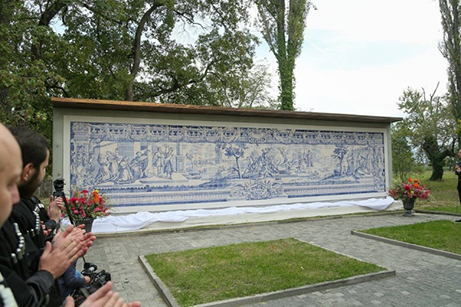17th century Georgian queen’s remains from Goa to be exhibited in homeland

Sacred remains of a medieval Georgian regent tortured in Persia for her faith will be returned to the country for exhibitions and pilgrimage after successful conclusion of talks between cultural agencies of Georgia and India this week.
Remains of the 17th century Queen Ketevan will go on display at museum and religious venues and will be on public view for history enthusiasts and the faithful for six months.
An announcement by the Ministry of Culture and Monument Protection of Georgia revealed the news earlier today, but did not specify when the occasion would take place.

A Georgian-based replica of a panoramic display of the torture of Queen Ketevan from the Convento da Graca Church in Portugal’s capital Lisbon. Photo: Embassy of Georgia in Portugal.
The queen's remains will go on display at the Georgian National Museum as well as the Holy Trinity Cathedral in Tbilisi and Orthodox Church eparchies across the country.
While museum-goers and church followers visit the venues hosting the remains, an international conference will bring together historians and experts from cultural agencies to discuss research and conservation efforts related to the legacy of the queen.
Known as Ketevan the Martyr after she was posthumously canonised by Patriarch Zachary of Georgia in the 17th century, the queen was tortured and killed in the Persian city of Shiraz in 1624 at the hands of Shah Abbas I of Persia.
She ended up in Persian captivity in 1614 after embarking on the trip to negotiate with the shah before surrendering herself in a bid to prevent an imminent Persian invasion of the East Georgian Kingdom of Kakheti.
She was tortured and killed after refusing to renounce her Christian faith and convert to Islam while in captivity. The torture was witnessed and documented by Catholic missionaries from Portugal, who later secretly excavated her body and transferred it to an Augustine monastery in Isfahan.
Later some of the regent's remains were brought to Georgia, where they were preserved at the Alaverdi Cathedral until 1723, when they were lost.
Some of the other remains ended up in a Church of St. Augustine in Goa, India, as well as in Vatican and Belgium.

The 1624 torture of the queen represents a significant historical event for Christianity and the Georgian Orthodox Church. Photo: Embassy of Georgia in Portugal.
Following the collapse of the Goa church in the 19th century, the remains preserved there went missing until 2013, when the magazine Archaeology released information on unidentified remains found among the ruins of the monastery.
The magazine said a DNA analysis of bones discovered in the location showed the remains indicated a Georgian origin, thereby linking them to Queen Ketevan.
The talks on transporting the queen's remains to Georgia have involved efforts from the National Agency for Cultural Heritage Preservation of Georgia.
The agency has also been involved in a restoration of a historical panoramic tile panel, depicting the 1624 torture of the queen in Persia and preserved at the Convento da Graca Church in Portugal’s capital Lisbon.
Created by Portuguese experts in the late 17th Century using faience and porcelain tiles, the panoramic display was commissioned by the Catholic Church and later discovered in Lisbon by Georgian scientists and religious figures.
The National Agency for Cultural Heritage Preservation of Georgia supported the restoration of the panoramic tile panel in 2015, while a replica was created and transported to Georgia.
 Tweet
Tweet  Share
Share




